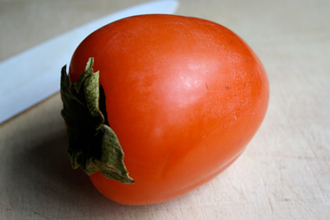Persimmons are prized in China, Japan and Korea but are often overlooked by Americans as one of the best all-around fruits, both in its delicate sweetness and pleasing texture, and as a virtual pharmacopeia of phyto-nutrients, vitamins and minerals.
Persimmons originated in China and spread to Korea and Japan in ancient times and were brought to California in the mid-19th century. A variety known as the fruit of sharon is also grown in Israel. They grow on multi-trunked or single-stemmed deciduous trees that can grow at high as 25 feet. Today persimmons are grown mostly in eastern China, southern Korea, central Japan, southern Brazil, parts of the Middle East, Italy and in small quantities in California and the East Coast of the US.
One reason for much ignorance about persimmons is the fact that there are actually two varieties that require different handling and eating. One variety (hachiya in Japan, hongshi in Korea and sheng in China) bears highly astringent fruit that can only be eaten after it has become very soft, almost jellylike, through proper ripening. The other variety (tan gam and gwang yang in Korea, fuyu, izu and taishu in Japan) is non-astringent and ripens fairly hard like an apple.
The persimmon was known as the fruit of the gods by the ancient Greeks, hence the scientific name diospyros (god’s fire). The name was given not only for the taste but for its healthful and medicinal qualities. An average size persimmon contains about 70 calories, though some persimmons can be quite large — weighing up to a pound — and would contains up to about 200 calories.
Persimmons contain high amounts of phyto-nutrient anti-oxidants like catechins that provide anti-infective benefits and are anti-inflammatory by preventing bleeding from small blood vessels. They also contain the anti-tumor compound betulinic acid.
They’re also full of the anti-oxidant, anti-aging compounds vitamin-A, beta-carotene, lycopene, lutein, zeaxanthin and cryptoxanthin that scavenge free radicals and reactive oxygen species (ROS) that plays a role in aging and various disease processes.
Zeaxanthin is a carotenoid that’s especially important for eye health. It is selectively absorbed into the retinal macula lutea to provide antioxidant and protective light-filtering functions. It’s a good way to prevent age related macular disease (ARMD) in the elderly.
Persimmons are a good source of vitamin C, with the native Chinese and American varieties providing over half of DRI. They provide over twice the RDI of the B vitamin riboflavin, as well as beneficial amounts of the other B vitamins folate, pyridoxine and thiamine — all of which aid various energy-producing processes.
Persimmons are also a good source of dietary fiber and are rich in minerals like manganese, potassium, phosphorus and copper (12% of DRI), a little considered mineral that is a co-factor for many vital enzymes, including cytochrome c-oxidase and superoxide dismutase (other minerals function as cofactors for this enzyme are manganese and zinc). Copper is also crucial for red blood cell production.


